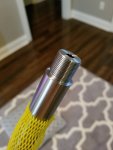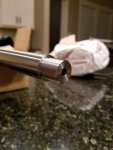Does the choice of barrel thread pitch matter when it comes to consistent accuracy in a competition rifle ?
With the move to heavier barrels, is the weakest link now in the crown if you choose a thread pitch that takes off more “meat” than one that doesn’t ?
Assuming all work being equal, should we favour thread pitches that leave as much metal around the crown as possible, as that’s likely to be the first part of the rifle to go from an accuracy perspective under heat / long strings of fire ?
Is one thread pitch more suitable for competition than another ?
Thanks, curious to hear your thoughts.
With the move to heavier barrels, is the weakest link now in the crown if you choose a thread pitch that takes off more “meat” than one that doesn’t ?
Assuming all work being equal, should we favour thread pitches that leave as much metal around the crown as possible, as that’s likely to be the first part of the rifle to go from an accuracy perspective under heat / long strings of fire ?
Is one thread pitch more suitable for competition than another ?
Thanks, curious to hear your thoughts.




